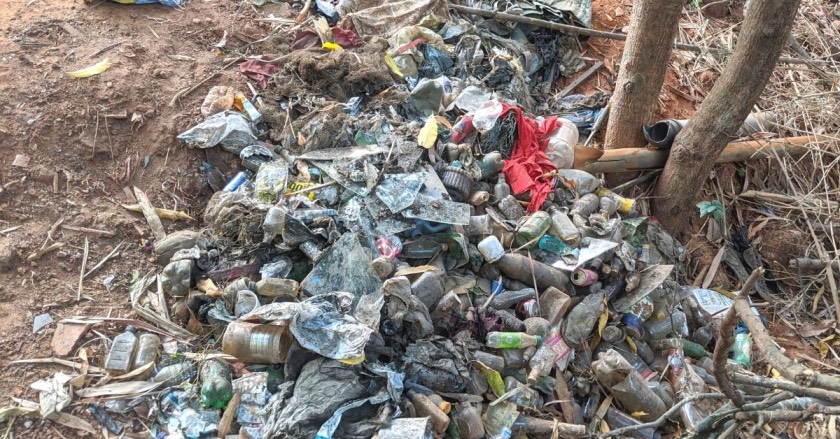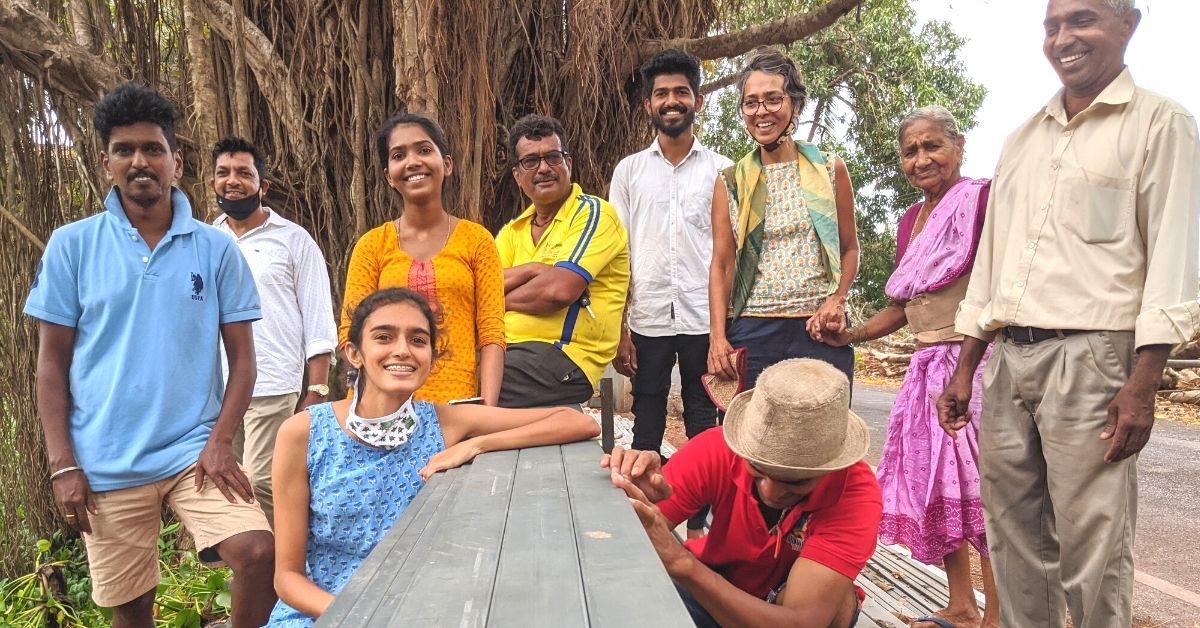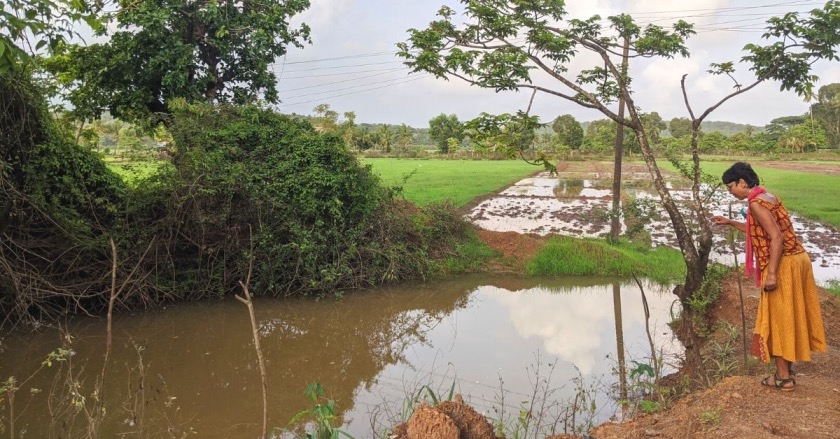One day in the summer of 2020, Harshada Kerkar from Saligao, Goa, noticed two wounded and infected buffaloes across the street from her window. The sight was especially painful to the 55-year-old artist, who has always held a special affection towards buffaloes and cows. For the last 30 years, she has watched the animals come to the pond near her house to take a dip in the hot summers. But the number had since dwindled, and the animals were often diseased, and had swollen knees due to infections.
Her search for the owners took her far and wide, but was eventually futile. She knew the problem was beyond only injured buffaloes in need of medical attention.
“There are around 1,500 water ponds in the village. These ponds serve as a safe habitat for buffaloes, especially during the summer, as the animals come here to seek respite from the heat. However, many of these ponds are in poor condition, owing to the waste thrown in by locals. In a few instances, the sewage is also directed to them. Some have dried up and are filled with debris. All these have become a cause of infection among the buffaloes,” Harshada tells The Better India.
A lack of coexistence

She says in March, she learned that three buffaloes had been poisoned to death. “People have foolishly restricted access to these animals, and deprived them of their natural habitat. At times, there are concrete borders or fencing around the ponds, making them inaccessible. Killing the animals is another way of refusing to share natural resources,” she adds.
Harshada shared her helplessness with friends, and her niece Sharada, who is a community development professional. Sharada roped in various community members, and the aunt and niece collected funds to revive five ponds in the village. The duo has now also identified an additional eight ponds for which work will begin soon.
“Harshada cares deeply for cows and buffaloes, and often says she understands their emotions. On many occasions, I have seen her sketching the buffaloes in the field from her window,” says Sharada (28). She agrees with her aunt’s concerns about the state of the animals. “Grazing pastures for buffaloes have reduced. Animals have to walk long distances to take a dip, and there are hardly any ponds with water left,” she adds.
The COVID-19 pandemic allowed Sharada to join her aunt in saving the buffaloes. “We discussed the matter with our friends and neighbours in the community to clean up the pond in front of our house. Fortunately, everyone agreed,” she says, adding that people came forward to donate money, provide expert advice on conservation, help in the clean up, and help out in various ways to revive the pond.
It took just one week for the team to collect Rs 6,000 and begin the work. They formed a citizen action group called CatcH2o, and roped in migrants who had lost employment due to the pandemic.
The work began by removing the rubbish from the Saligao pond. “We were shocked to see the number of liquor bottles, cans, and plastic waste that was choking the water body and damaging the biodiversity. The water body looked like a landfill,” Harshada recalls.

The next step was to revive the ecosystem using a combination of scientific methods and natural processes. Aaron Savio Lobo, a marine conservationist, says, “We first cleaned accumulated waste and weeds from the ponds. Then, we let nature take its course. Sometimes, it’s best not to do too much.”
Lobo says caution should be maintained regarding the intensity of digging and dredging taken up in the habitat. “The natural terrain and topography cannot be disturbed. The conservation work needs to be approached carefully, and introducing non-native species or elements may harm rather than heal the ecology,” he adds.
Aaron says “We retained – and if necessary, planted – native species based on reference sites in the vicinity. These included riparian species such as Screwpine (pandanus), Jamun (Syzygium cumini), and Black Varnish tree (Holigarna arnottiana), as these occurred near the edges of water bodies in these areas.”
Anthony D’Souza, an environmentalist and expert in village-level biodiversity management, contributed by propagating native plant species. “We also emphasise permaculture, to ensure that the size of the pond does not shrink with the dumping, piling up of waste and loss of biodiversity. Perennial grasses, which are easily available and allow water to percolate, were planted to protect the area,” he adds.
To protect the ponds from encroachment, Hyacinth Pinto, an architect and a friend of Harshada’s, helped by creating a protective wall from cob (made from clay and biomass). “The boundary of the pond should perform multiple roles, such as allowing water to percolate in the ground to raise the water table, prevent soil erosion, and work as a healthy catchment area. Clay and soil are used instead of concrete or stones, which affect the habitat adversely,” she adds.
Explaining the immediate impact, Aaron says, “Removal of invasive weeds like the water hyacinth helped in a few areas. We saw the return of many species of waterbirds, two species of turtles, and local favourites such as the walking catfish Clarias dussumieri, locally called Tigur.” The species is endemic to freshwater bodies in western India and faces threats because of habitat shrinkage and invasive species.
Taking note of their efforts, the volunteers received funds from the Rotary Club, which allowed them to revive four other ponds in Saligao, Pilerne and Marra.
‘A sense of ownership’

Though the work bore fruit for the spirited Goans, raising funds for upcoming work and maintaining the recently revived ponds remains an uphill task. “The main aspect is the availability of funds. Maintaining the revived ponds further depends on the community, which expects direct benefits from the conservation efforts and is willing to work towards it. Involving the community and instilling a sense of belongingness in the protection work helps preserve biodiversity,” he says, adding that if people have access to water, weeds, and vegetables from the ponds, they will want to protect it.
“There are people who could access a few crops and water in earlier days. Some residents just sat along the ponds. Such connections will ensure the survival of these ponds,” Aaron explains.
Aaron says that preventing sewage water from entering these blocks is another hurdle. “We are working to keep natural springs that replenish the ponds flowing through the year,” he says.
Hyacinth agrees that community engagement is required for environmental causes. “Such projects cannot succeed unless there is a sense of ownership through contributions at the ground level. The contributors become stakeholders and prevent from causing damage to the hard work they have put in,” she adds.

“There is over-extraction of water from these ponds and borewells, which directly impacts the groundwater table and threatens the habitat. We plan to reach out to the biodiversity conservation board and wetland authorities of the government to support the cause,” Hyacinth adds.
Sharada says that buffaloes are now returning to the clean Saligao pond. “However, only getting buffaloes back in the water is not our aim. It is to conserve the environment,” she adds.
Edited by Divya Sethu
No comments:
Post a Comment